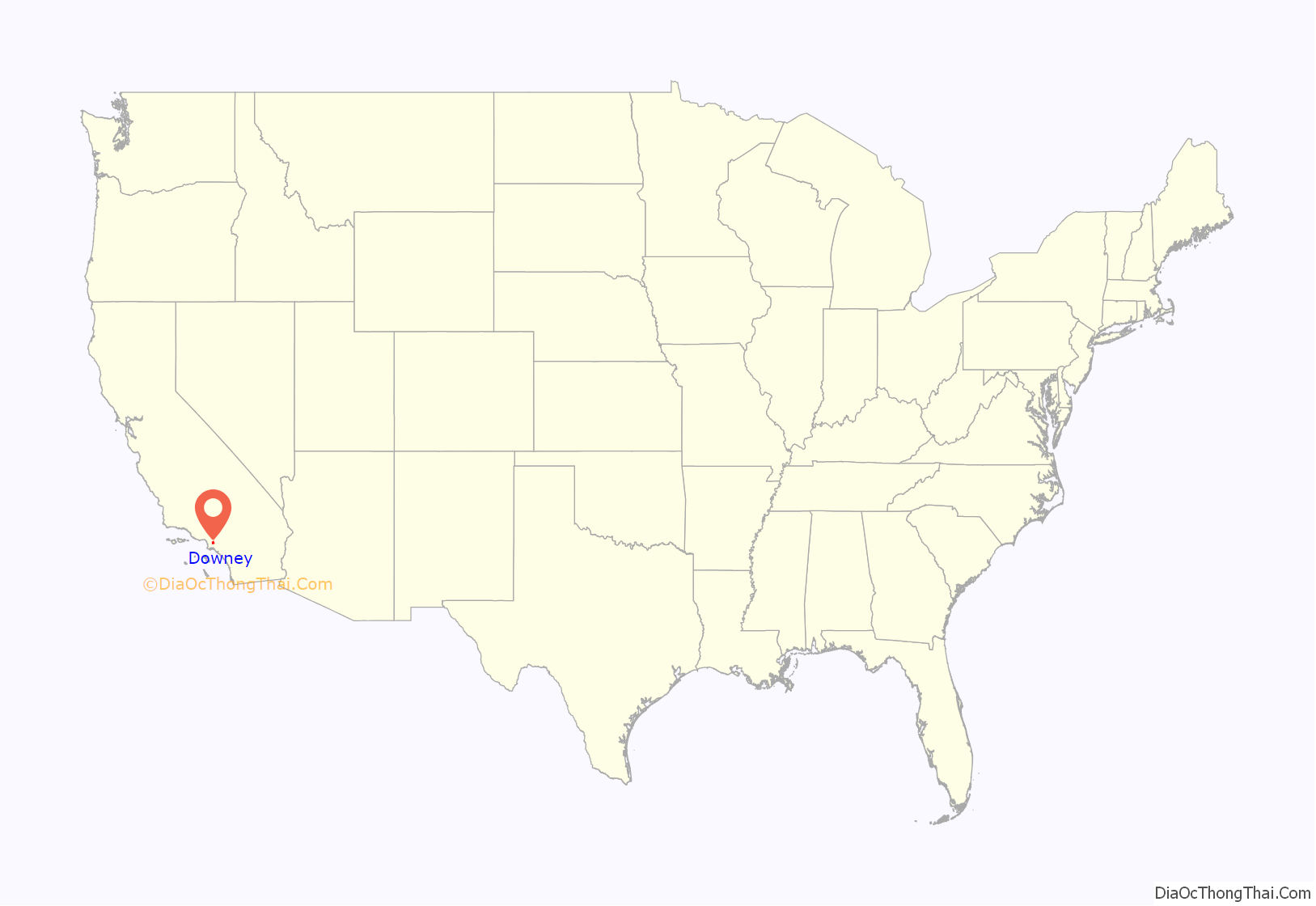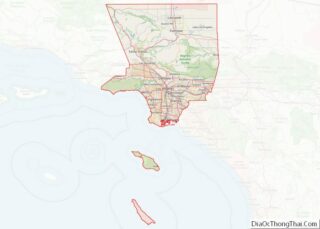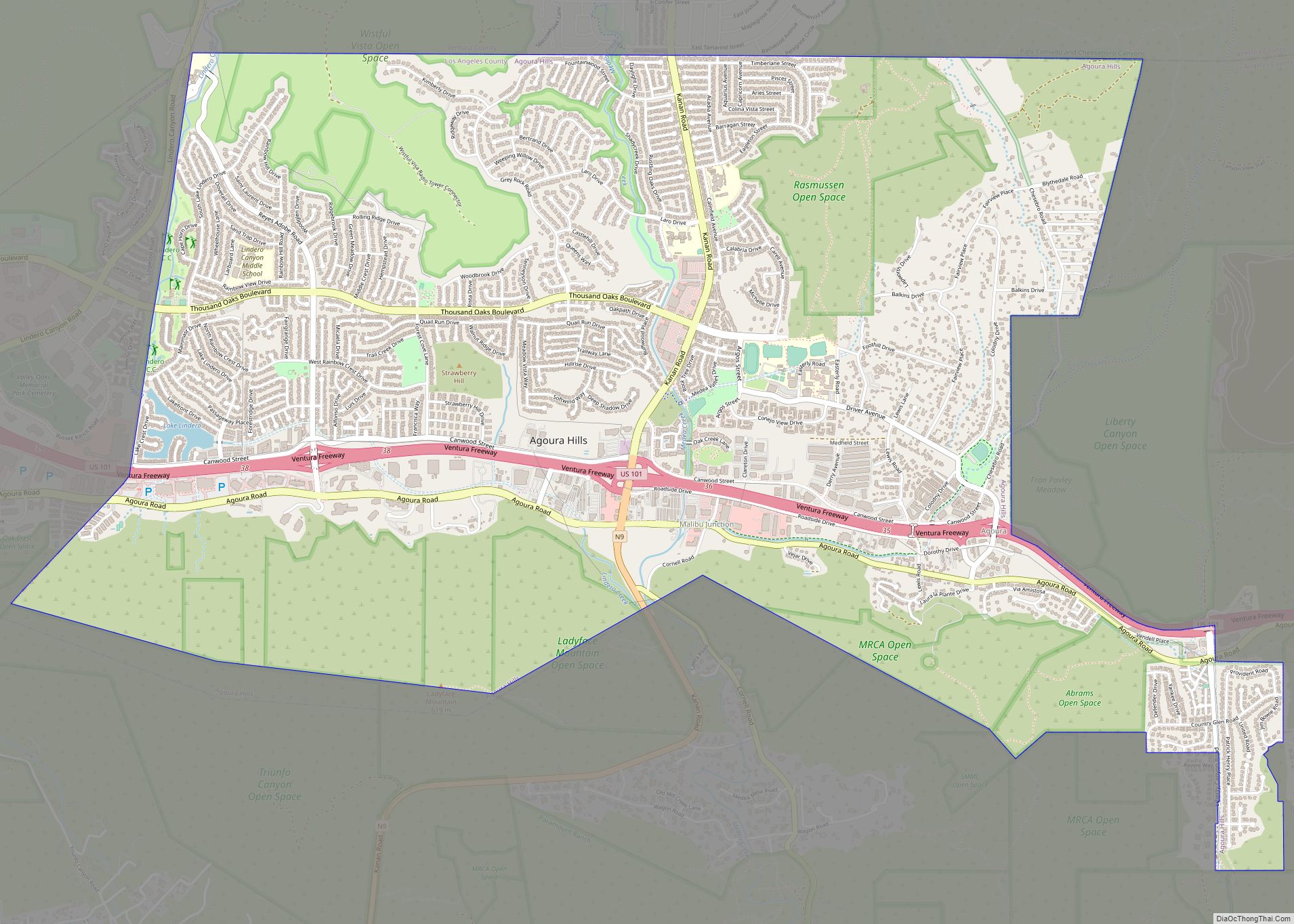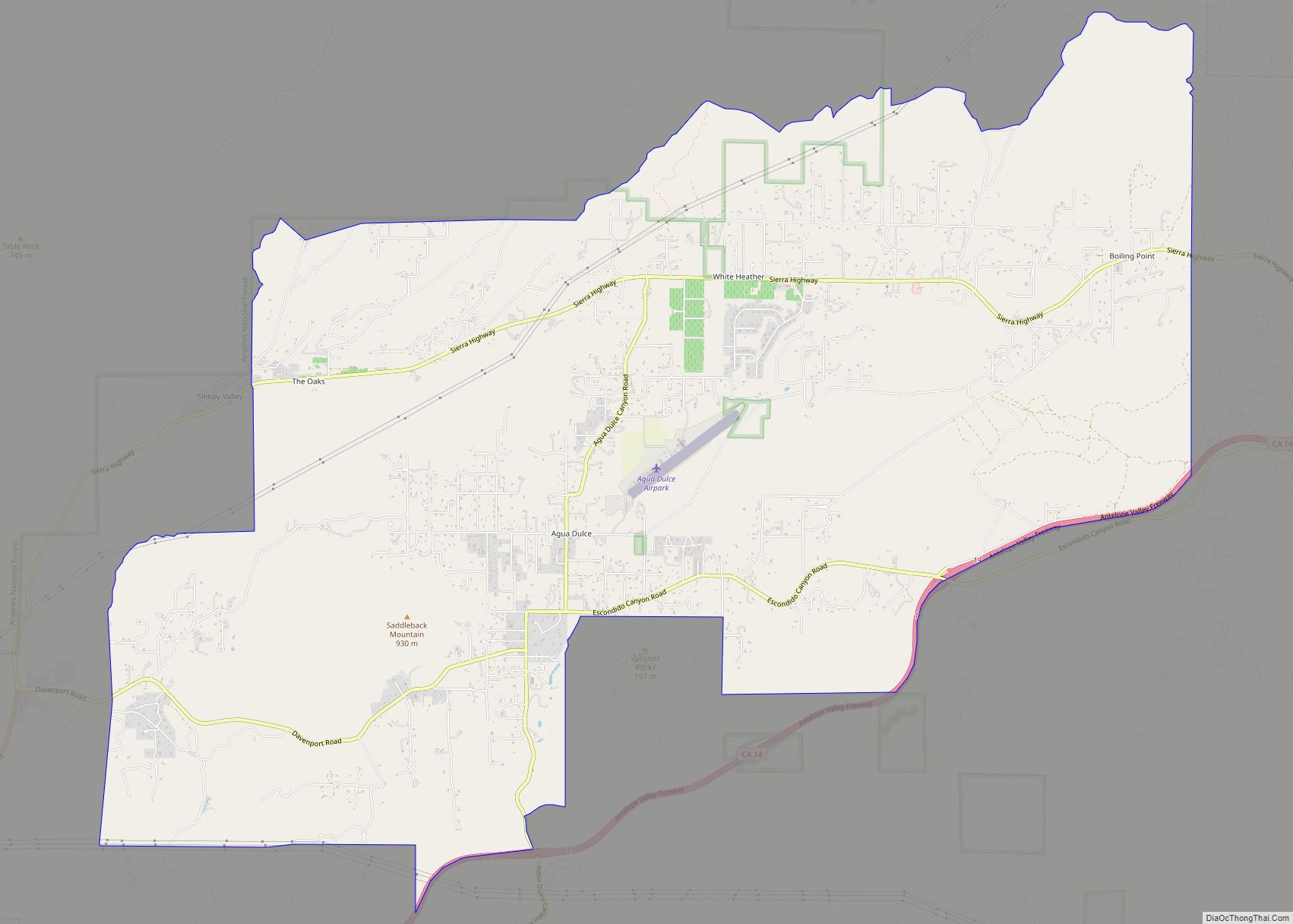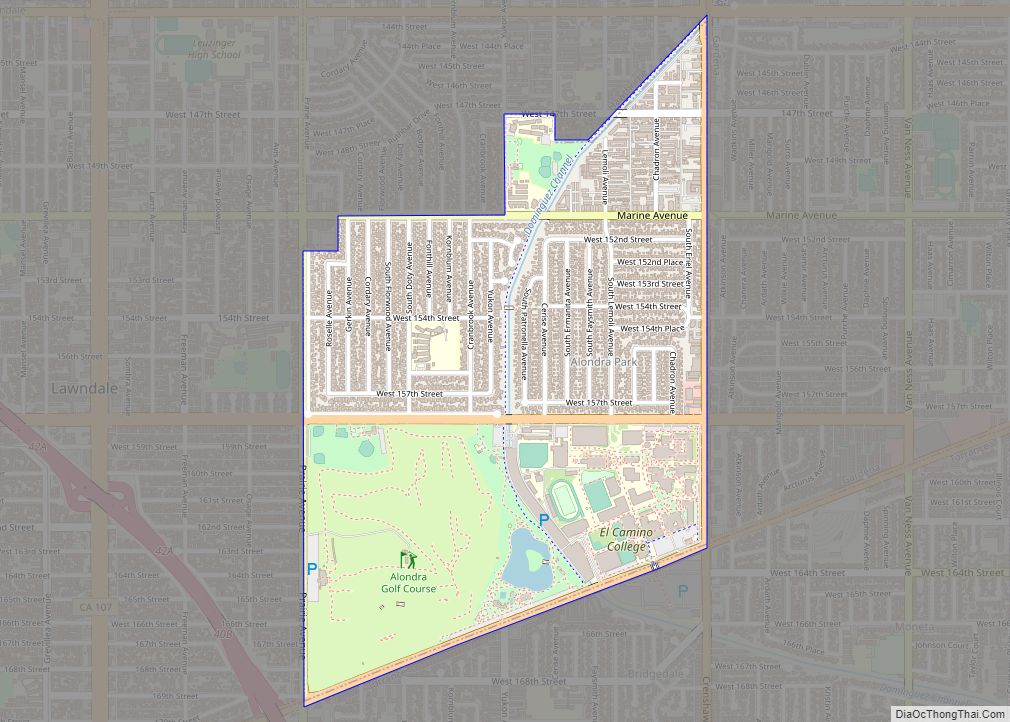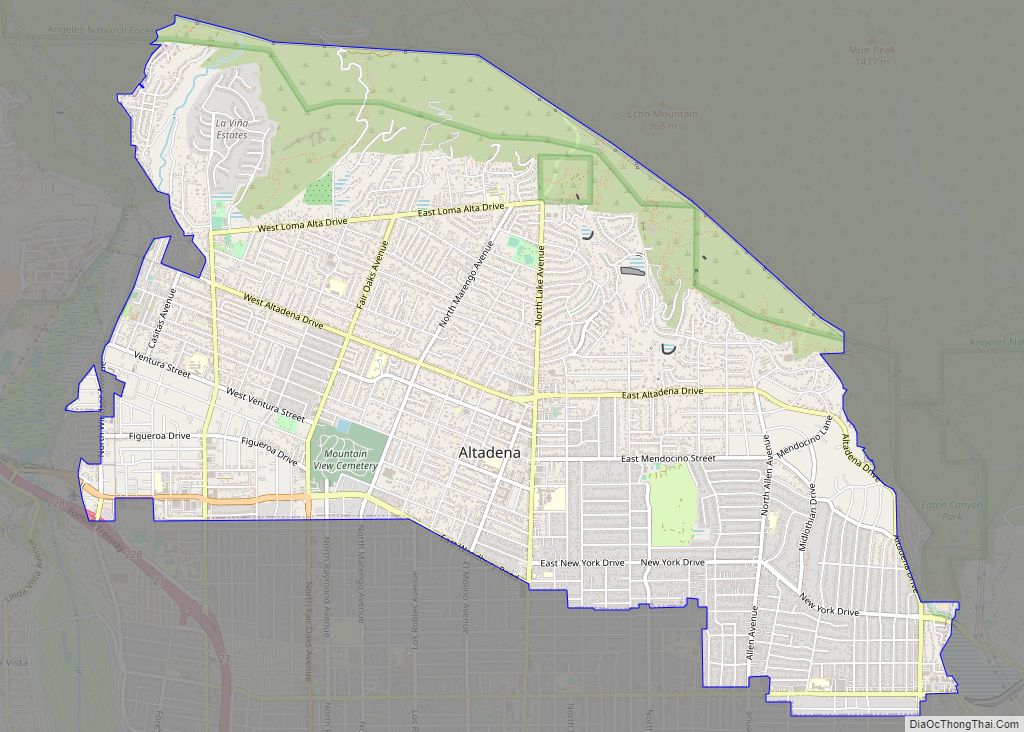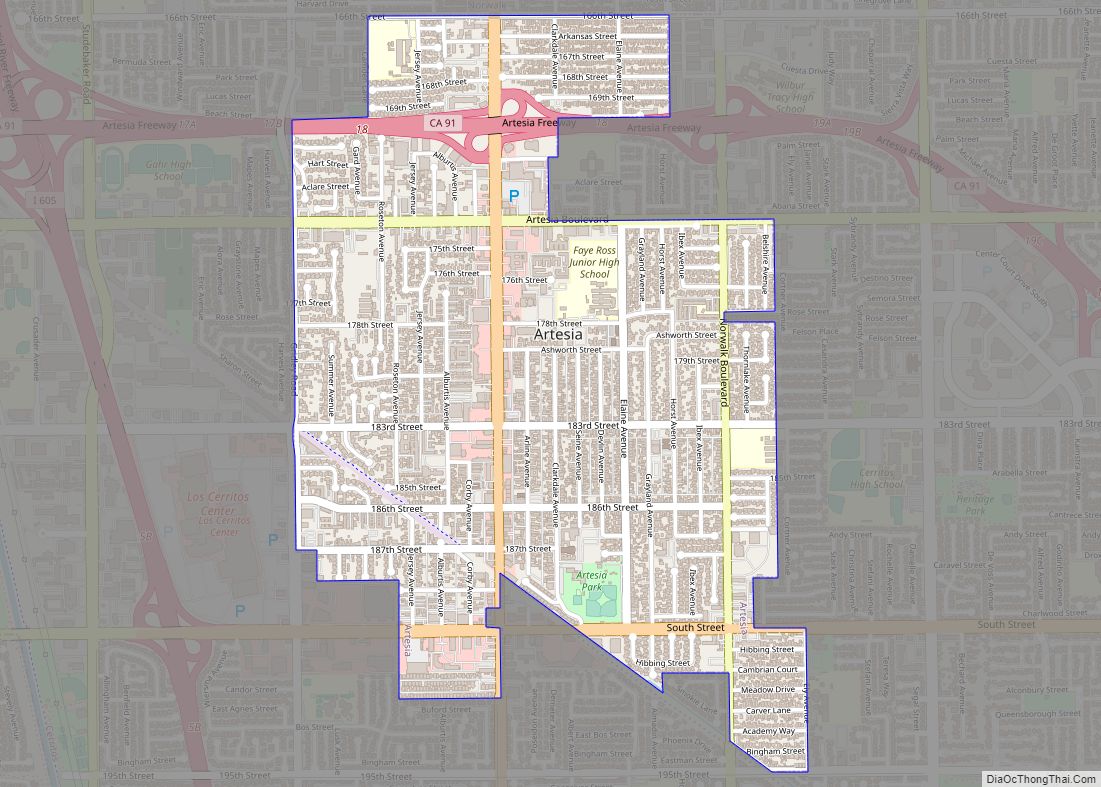Downey is a city located in Southeast Los Angeles County, California, United States, 13 mi (21 km) southeast of Downtown Los Angeles. It is considered part of the Gateway Cities. The city is the birthplace of the Apollo space program. It is also the home of the oldest operating McDonald’s restaurant in the world. As of the 2020 census, the city had a total population of 114,355.
| Name: | Downey city |
|---|---|
| LSAD Code: | 25 |
| LSAD Description: | city (suffix) |
| State: | California |
| County: | Los Angeles County |
| Founded: | October 23, 1873 |
| Incorporated: | December 17, 1956 |
| Elevation: | 118 ft (36 m) |
| Total Area: | 12.57 sq mi (32.55 km²) |
| Land Area: | 12.41 sq mi (32.14 km²) |
| Water Area: | 0.16 sq mi (0.42 km²) 1.27% |
| Total Population: | 114,355 |
| Population Density: | 9,215.49/sq mi (3,558.25/km²) |
| Area code: | 562 |
| FIPS code: | 0619766 |
| Website: | www.downeyca.org |
Online Interactive Map
Click on ![]() to view map in "full screen" mode.
to view map in "full screen" mode.
Downey location map. Where is Downey city?
History
18th century to World War II
Mission San Gabriel Arcángel was initially founded on September 8, 1771, near settlements of the Tongva people. It was located in the Whittier Narrows on a bluff overlooking the Rio Hondo, near the intersection of today’s San Gabriel Blvd and Lincoln Avenue. After five years, flooding forced the relocation of the mission to its present site in San Gabriel.
In 1784, Governor Pedro Fages granted to former soldier Manuel Nieto (1734–1804) the largest of the land concessions made in what was then Alta California, a province of New Spain. Its 300,000 acres (120,000 ha; 1,200 km) stretched from the Santa Ana River on the east to the Old San Gabriel River (now the Rio Hondo and Los Angeles River) on the west, and from the mission highway (approximately Whittier Boulevard) on the north to the ocean on the south. Its acreage was slightly reduced later at the insistence of Mission San Gabriel on whose lands it infringed. The Spanish concessions, of which 25 were made in California, were unlike the later Mexican land grants in that title was not transferred but were similar to grazing permits with the title remaining with the Spanish crown.
The Rancho Los Nietos passed to Manuel Nieto’s four children upon his death and remained intact until 1833 when his heirs petitioned Mexican Governor José Figueroa to partition the property. The northwestern portion of the original rancho, comprising the Downey-Norwalk area, was granted as Rancho Santa Gertrudes to Josefa Cota, the widow of Manuel’s son, Antonio Nieto. At approximately 21,000 acres (8,500 ha; 85 km), Santa Gertrudes was itself a sizable rancho and contained the old Nietos homestead, which was a center of social life east of the pueblo of Los Angeles. After the Mexican–American War concluded in 1848, many of the Californio ranchos were obtained by affluent Anglo-Americans who were immigrating west under the United States manifest destiny doctrine, and marrying into established Californio Spanish families. This migration was distinct from that prompted by the California Gold Rush farther north.
Dairy was a major industry in Downey. The Central Milk Agency marketed the milk for “seven hundred dairymen whose dairy herds range from thirty to two thousand head” with the value of the products marketed in excess of $1,000,000 per month.
Some of Downey’s settlers came from Ireland. Downey was founded by and named for the former and youngest ever governor of California, John Gately Downey, who was born in Ireland. Although he was an Irish Democrat, he supported the Republican Lincoln in his efforts to keep the Union intact during the American Civil War. He pioneered the modern subdivision with land he acquired between the Rio Hondo and the San Gabriel River, in about 1865. Downey was convinced that oranges would flourish in Southern California, so he imported several varieties, and therefore set in motion what became one of the state’s biggest cash crops. In conjunction with the construction of the Tehachapi Loop, the Southern Pacific Railroad arrived in 1873.
Gallatin
Two small settlements were established along the Rio Hondo River – College Settlement and Gallatin, the latter near where today, Paramount Boulevard and Florence Avenue cross. In the late 1860s the Gallatin residents built a small school known as the “Little Red Gallatin School House”. By 1871, it was not large enough and a two-story school was built. Gallatin School moved in 1893 to its present site. Later, Alameda School and Downey School were built. By 1883, College Settlement, Gallatin, and Downey joined together, and with the help of Governor Downey convinced the Southern Pacific Railroad to route through and stop in Downey. The new center of activity migrated to the depot area, and this became the center of a new larger Downey, uniting the three previous settlements.
After World War II
Farmers in the area grew grain, corn, castor beans, and fruit, and by 1935 Downey was characterized as an “orange-grove town”. Downey was incorporated in 1956 and instituted a charter form of government in 1964. Suburban homes and factories replaced the farms after World War II.
Vultee Aircraft was Downey’s largest employer during World War II producing 15% of all of America’s military aircraft by 1941. The company was a pioneer in the use of women in manufacturing positions and was the first aircraft company to build airplanes on a powered assembly line. Vultee became a part of North American Aviation (later North American Rockwell, then Rockwell International which was then bought by the Boeing company) whose facilities were the birthplace of the systems for the Apollo Space Program as well as the Space Shuttle. For over 70 years, Downey’s Rockwell NASA plant produced and tested many of the 20th century’s greatest aviation, missile, and space endeavors.
By the early 1970s, the facilities encompassed some 1,700,000 square feet (160,000 m) of enclosed area over more than 200 acres (81 ha). But, by the post-Cold War 1990s, Downey was severely hit by cutbacks in the defense budget. Rockwell International which once had more than 30,000 employees had fewer than 5,000 in 1992. The seventy-year history of airplane and space vehicle manufacturing in Downey came to an end when the Rockwell plant closed in 1999. The former North American Rockwell plant was demolished, and the site now features the Columbia Memorial Space Center, Downey Landing shopping center, Promenade at Downey shopping center (the former movie studio site of Downey Studios), a Kaiser Permanente hospital, and a city recreation fields park.
Near the center of the city lies what was in the 1960s one of the busiest intersections in California, the intersection of Lakewood Boulevard (State Route 19) and Firestone Boulevard (former State Route 42). Route 19 was a major thoroughfare between Pasadena and the port at Long Beach and Route 42 was along part of the old Spanish El Camino Real trail that connected Pueblo de Los Angeles to San Diego.
In the 1960s, the town’s Downey Records achieved some notoriety with recordings such as The Chantays’ surfing instrumental “Pipeline”; nearly two decades later, Downey local music scene led to the founding of The Blasters and Dark Angel.
Downey is home to Rancho Los Amigos National Rehabilitation Center which is the main public rehabilitation hospital for Los Angeles County. Rancho Los Amigos is renowned worldwide for its innovative contributions to the care of spinal cord injuries and post-polio syndrome.
Downey was featured in the 2008 American action-comedy film Pineapple Express. Many of the buildings along Florence Avenue are seen in a driving sequence early in the film.
Downey Road Map
Downey city Satellite Map
Geography
According to the United States Census Bureau the city has a total area of 12.6 square miles (33 km). 12.4 square miles (32 km) of it is land and 0.2 square miles (0.52 km) of it is water.
The cities of South Gate and Bell Gardens are adjacent to the west and northwest, Pico Rivera lies to the northeast, Santa Fe Springs and Norwalk to the east, and Paramount and Bellflower are to the south.
Climate
According to the Köppen Climate Classification system Downey has a semi-arid climate abbreviated “BSk” on climate maps.
See also
Map of California State and its subdivision:- Alameda
- Alpine
- Amador
- Butte
- Calaveras
- Colusa
- Contra Costa
- Del Norte
- El Dorado
- Fresno
- Glenn
- Humboldt
- Imperial
- Inyo
- Kern
- Kings
- Lake
- Lassen
- Los Angeles
- Madera
- Marin
- Mariposa
- Mendocino
- Merced
- Modoc
- Mono
- Monterey
- Napa
- Nevada
- Orange
- Placer
- Plumas
- Riverside
- Sacramento
- San Benito
- San Bernardino
- San Diego
- San Francisco
- San Joaquin
- San Luis Obispo
- San Mateo
- Santa Barbara
- Santa Clara
- Santa Cruz
- Shasta
- Sierra
- Siskiyou
- Solano
- Sonoma
- Stanislaus
- Sutter
- Tehama
- Trinity
- Tulare
- Tuolumne
- Ventura
- Yolo
- Yuba
- Alabama
- Alaska
- Arizona
- Arkansas
- California
- Colorado
- Connecticut
- Delaware
- District of Columbia
- Florida
- Georgia
- Hawaii
- Idaho
- Illinois
- Indiana
- Iowa
- Kansas
- Kentucky
- Louisiana
- Maine
- Maryland
- Massachusetts
- Michigan
- Minnesota
- Mississippi
- Missouri
- Montana
- Nebraska
- Nevada
- New Hampshire
- New Jersey
- New Mexico
- New York
- North Carolina
- North Dakota
- Ohio
- Oklahoma
- Oregon
- Pennsylvania
- Rhode Island
- South Carolina
- South Dakota
- Tennessee
- Texas
- Utah
- Vermont
- Virginia
- Washington
- West Virginia
- Wisconsin
- Wyoming
